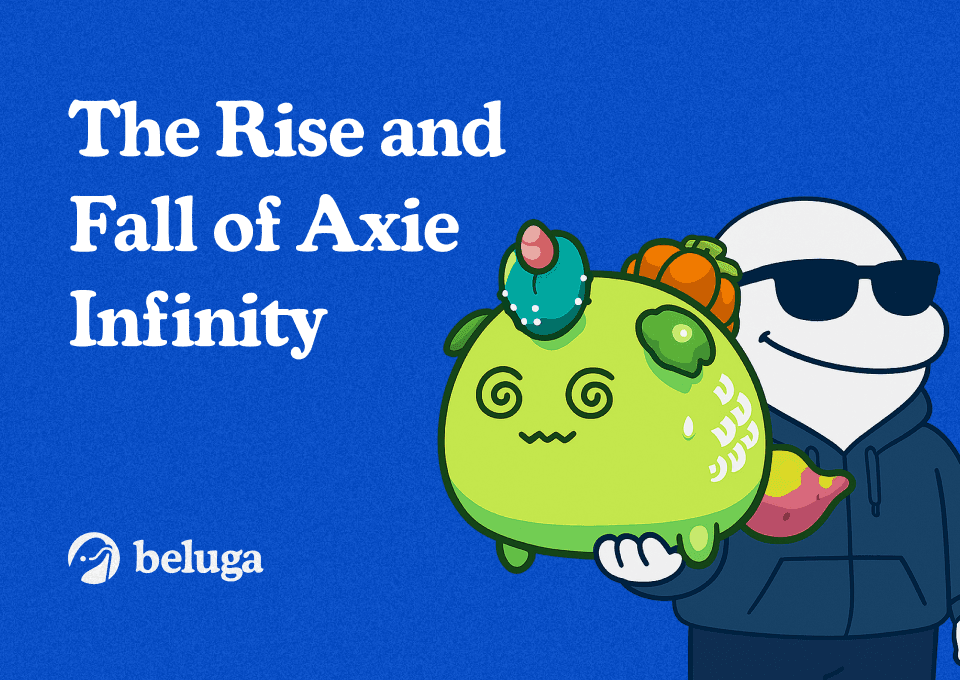The Rise and Fall of Axie Infinity
By Will Tolmie Updated June 13, 2025

Summary
- Axie Infinity is blockchain-based video game which initially surged in popularity due its play-to-earn model.
- Unsustainable economic mechanics and exploitative player dynamics led to the game's sharp decline.
- The blockchain gaming industry is now shifting towards "play-and-earn" models.
Introduction
For the uninitiated, Axie Infinity is one of the first "play-to-earn" video games to use blockchain technologies. Released in 2018 by Sky Mavis, Axie Infinity involves a marketplace where players can trade NFTs which represent axolotl-inspired digital pets called Axies. Axies can be bred, battle with each other, and level up through in-game activities, all the while earning in-game currency (and real-life cryptocurrency) called Smooth Love Potion (SLP), which can be exchanged for other cryptocurrencies. Axie Infinity's daily active user population peaked in November 2021 at over 2.7 million. Today, that number stands at 52,659 users. Follow along to learn why Axie Infinity's economic structure was unsustainable and how the blockchain-based video game developers of today are learning from the mistakes of Sky Mavis.

Axie Infinity's Initial Success
Axie Infinity skyrocketed in popularity after COVID-19 lockdowns crippled the global economy when its players discovered the game alone could pay their cost of living. The game's innovative play-to-earn structure captured attention particularly in economically vulnerable countries such as Venezula and the Philippines. Players from these countries reported earnings from Axie Infinity that were substantially larger than local employment opportunities, which attracted global media coverage and further boosted user growth.
At one point, players from the Philippines made up 40% of Axie Infinity's user base. This period of explosive growth at first demonstrated the potential of blockchain-based gaming to positively impact real-world economies.
How Axie Infinity Was Built to Fail
One key vulnerability in Axie's economic structure was the substantial upfront cost for players. A set of three Axies initially cost over $1,000. While entry prices have now fallen, this barrier to entry led to the emergence of exploitative player dynamics. Many players engaged in "scholarships," a term for informal arrangements where wealthier, more experienced players designated "managers" loan Axies to "scholars," newer players from economically disadvantaged regions, in an exchange for a significant cut of their earnings.
Another flaw in the economic structure of Axie Infinity is the game's reliance on constant influxes of new players. While early players profited significantly, newer entrants see diminishing returns, and the value of SLP has collapsed as user growth has slowed alongside a major hack in March 2022 that drained approximately $600 million from Ronin, the blockchain network underlying Axie Infinity. At its peak, the SLP token was worth 39 cents. Today, it stands at less than a quarter of a penny.
The declining value of SLP, combined with the increasingly competitive, high-stress nature of Axie Infinity's gameplay, eventually led to disillusionment among its player base. Axie Infinity's unsustainable and unreliable economic mechanics have even led to comparisons of the game to a Ponzi scheme.
Learning from Axie Infinity
Axie Infinity's economic collapse and sharp decrease in popularity prompted critical reflections within the blockchain gaming industry. Industry leaders are now shifting toward a "play-and-earn" model, emphasizing engaging gameplay first and monetary rewards as secondary benefits and avoiding the aforementioned pitfalls in Axie Infinity’s model. One example of the "play-and-earn" concept is NEXUS World, a virtual universe with a native cryptocurrency players can use to purchase virtual land. Players can also redeem this cryptocurrency for real-world products and privileges, including such as special deals on real-world vacations.
 With promising innovations such as NEXUS World, blockchain gaming has become a significant sector within cryptocurrency. GameFi is projected to become a $50 billion market by the end of this year, and investors and developers are increasingly prioritizing gameplay quality and sustainability over financial returns. The industry's evolution now focuses on enhancing player experiences through exciting gameplay mechanics and reduced exposure to economic volatility.
With promising innovations such as NEXUS World, blockchain gaming has become a significant sector within cryptocurrency. GameFi is projected to become a $50 billion market by the end of this year, and investors and developers are increasingly prioritizing gameplay quality and sustainability over financial returns. The industry's evolution now focuses on enhancing player experiences through exciting gameplay mechanics and reduced exposure to economic volatility.
Conclusion
Axie Infinity's trajectory from unprecedented success to stark failure serves as a critical lesson for the developers of blockchain games. The industry's ongoing adjustments away from play-to-earn games suggest a hopeful path forward, striving toward gaming that prioritizes player enjoyment and long-term stability.
Join the Beluga Brief
Dive deep into weekly insights, analysis, and strategies tailored to you, empowering you to navigate the volatile crypto markets with confidence.
Never be the last to know
and follow us on X








